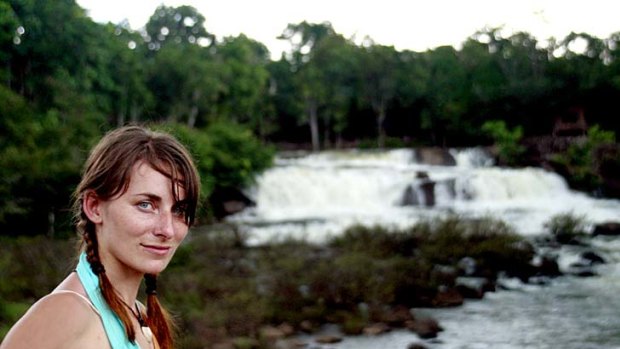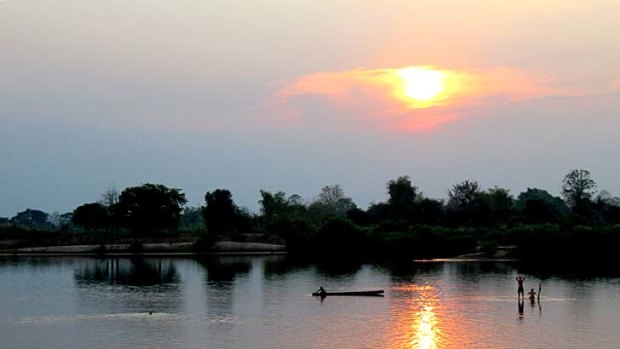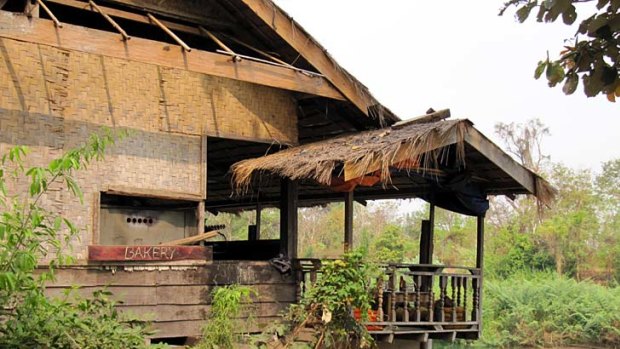
The Si Phan Dhon region has become a new mecca for young travellers.Credit: Getty Images
Toby Johnstone discovers a different kind of island escape in budget-friendly Laos.
Every now and then on the Laos hippy trail you spy a traveller wearing a T-shirt that reads “Been There Don Det”. Most people think it is yet another pun based on the 'hilarities' of the language barrier (see “Same Same But Different”) but actually it's an inside joke for those who had ventured far enough south to visit a small island hidden in the mist of the Mekong River.
South of the capital Vientiane, the Mekong breaks its banks creating an anarchic sprawl of islands called Si Phan Don, which translates to "4000 Islands". Don Det – only four kilometres long – is one of the larger islands. For centuries, longboats and canoes have carted fish and fresh produce up and down the river but today the cargo includes white-knuckled Westerners clutching their Lonely Planets.
Trying to keep my weight centered, aware that an ill-timed sneeze could capsize the boat, I distract myself by counting islands. Before I could bust the 4000 islands myth, we pass another longboat crammed with travellers wearing glum expressions. A bad omen for those heading towards the island these passengers have just left.
Our boat drops its cargo on the beach at the northern end of Don Det and, relatively dry, we jump off, navigate through clots of sunbakers and head up the main drag to find somewhere to stay.
I quickly come to a crossroad. This presents a simple, yet important, decision that will define the nature of my stay on the island: sunrise or sunset side? Using my skills of geographical deduction I opt for sunrise and head to the east, where simple bamboo huts run precariously along the river.

Sunset in Don Det ... enthusiasts opt to swim out to a sandbar marked with a solitary branch planted by travellers past.Credit: Elise Kuszlaba
Within minutes, a smiling Lao woman assures me that she has “best price” for me and I'm sold.
The room has the bare necessities; a double bed, fan and mosquito net. Through the cracks in the floorboards I can see my host retire to her makeshift hammock hanging from the base of my bungalow. I soon follow suit and, after some less then elegant gymnastics, settle into my hammock and gaze out at the Mekong.
The hammock is to Laos what Ikea is to Sweden. It's not just ubiquitous furniture but an expression of values. With a national ethos based on minimising stress and maximising múan (fun), things like time and deadlines become alien concepts. On these incidental mounds of earth set inside a shifting river, activities like hammocking lull you into the national rhythm.

Breakfast venue ... the Bakery.Credit: Elise Kuszlaba
It is from this suspended position I continue to ponder the real meaning of the T-shirt that led me here. The irony of the shirt (yes it is a joke that keeps on giving) is that upon arriving at this Mecca for hammock enthusiasts I find myself wondering what you actually do at Don Det. After five nights I set about writing a daily routine, which may help solve this puzzle:
Wake up. Depending on which direction you took at the crossroads this will either involve the gradual heating of your bungalow in the morning sun or the sound of the local kids riding bikes to school on the sunset side.
Breakfast. The Bakery on Sunrise cafe eases you into the day with recliner cushions and the smell of cinnamon scrolls fresh out of the oven. Depending on the inclinations of the Lao baker and her Australian expat husband there may also be mushroom and garlic scrolls and banana doughnuts.
Hit the 'road'. Or dirt path as it turns out. It may seem strange in a place called 4000 Islands but the transport of choice is bicycles. Although Don Det has restaurants and nightlife, the attractions in this region lie on the neighbouring island Don Khon. Riding south will take you to a concrete arched railway bridge linking the two islands. Built by the French in 1917 the bridge, now open to pedestrians, was built to circumvent the dangerous Mekong rapids and waterfalls. People stop to photograph an old rusted locomotive, abandoned along with the French plans to turn the Mekong into a super highway for trade between Saigon and China. Further along the trail dilapidated French villas have been converted into restaurants run by Lao locals. The menus advertise crepes and baguettes, highlighting the colonial legacy intertwined with modern Lao life.
Waterfalls. The French built that bridge for a reason. The tranquil Mekong regularly transforms into fast moving rapids that climax at Khon Phapheng Falls. Known as the 'spirit trap' in local folklore, millions of litres of water pump through jagged rocks en route to Cambodia.
Dolphins. Off the southern tip on Don Khon rare Irrawaddy river dolphins have made their home in a deep pool separating Laos and Cambodia. Charting a boat to navigate through the craggy rock outcrops is worth the trip even if you don't see the dolphins. However, catching a glimpse of their spectral forms surfacing in the afternoon sun before retreating into the murky depths of the Mekong is a sight that is not easily forgotten.
Sunset. Riding behind a troupe of kids returning home from school will lead you back to Don Det in time to watch the day end with a cold Beer Lao. More active sunset enthusiasts opt to swim out to a sandbar marked with a solitary branch planted by travellers past.
Dinner. Highlighting the cultural flows of the Mekong, the best restaurant on the island is Jasmines, an Indian curry house. Due to its popularity travellers settle in to play cards and swap stories, all the time teased by tantalising aromas from the kitchen. The food is well worth the wait. Generous servings and a variety of traditional and experimental dishes will leave you full and contemplating an early return to your hammock.
Nightlife. If you came to party hard, 4000 Islands is probably not the right place. The few bars in the area close up at 11:30 in accordance with the Laos curfew of midnight. That's the cue for travellers to stock up on candles and Beer Lao and head to the beach. Under starry skies travellers enjoy a different kind of nightlife to the evenings riverside at Vang Vieng or under a full moon in Thailand. There are no flaming skipping ropes, bars blasting Kanye West or nights that finish with projectile vomiting. Instead there are coteries of travellers, faces lit by flickering candles, listening to a dread-locked man playing covers on guitar (there is always one) and discussing how they discovered Don Det.
When the conversation inevitably turns to where they are going next, I recall the glum expressions of those I'd seen on the passing long boat. It made sense. The boats heading back to the main land are full of people lamenting the fact that they are leaving the island. They have already been there, Don Det.
FAST FACTS
Getting there
Thai Airways flights to Vientiane with a stopover in Bangkok. Vietnam Airlines also has flights to Vientiane via Hanoi but it takes considerably longer.
Buses can be organised through your guesthouse (recommended) or at the Southern Bus Terminal (Dong Dok). Overnight buses leave Vientiane at around 7pm and reach Pakse the next morning. It is recommended that you take out money in Pakse as there are no ATMs on the islands.
In Pakse you change to a minibus which takes you to the riverside town of Ban Nakasang (2 ½ - 3 ½ hours). From here the villagers run cheap boat services to the island of your choice (about 20 minutes to Don Det). See thaiairways.com.au, vietnamairlines.com.
Staying there
A riverside bungalow will cost you 50,000 kip (AUS $6) per night. Cheaper non-riverfront accommodation is also available for those on a really tight budget. More up market accommodation can be found on the north most point of the island at Little Eden. Run by Mathieu and his wife Noy, Little Eden has comfortable riverside rooms started at 175,000 kip (AUS $20) and a good restaurant adjoining.
Eating there
- Jasmine's Indian Restaurant is the pick of the lot on Don Det. There is a large variety of traditional and experimental Indian dishes with extensive vegetarian options. A perfect place to play cards and watch the moon rise over the Mekong.
- Veggie Patch Organic Farm Restaurant: A good place to stop in for lunch. Run by Alex, a Frenchman, and his Australian girlfriend Nic, this restaurant on the Sunset side is as free range as it gets. From small low tables you can follow the progress of your meal from the ground to your plate.
- The Bakery: Run by an expat Australian and his Laos wife this is the best place for fresh baked goods on the island. Overhanging the river, travellers settle into their daybeds and look forward to finding out what is next to come out of the oven. The mushroom and garlic scrolls are the go.
Sign up for the Traveller Deals newsletter
Get exclusive travel deals delivered straight to your inbox. Sign up now.